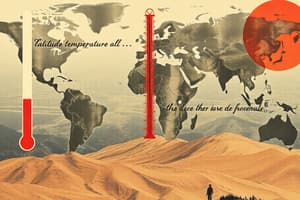Podcast
Questions and Answers
What is the primary role of ocean currents in transferring heat energy?
What is the primary role of ocean currents in transferring heat energy?
- To warm up the poles
- To transfer heat from temperate to tropical zones
- To transfer heat from tropical to temperate zones (correct)
- To cool down the equator region
How does unequal insolation impact the distribution of air temperature on Earth?
How does unequal insolation impact the distribution of air temperature on Earth?
- It leads to uniform air temperature worldwide
- It results in warmer air at the equator and cooler air at the poles (correct)
- It causes warmer air at the poles and cooler air at the equator
- It has no impact on air temperature distribution
In the context of ocean currents, where do warm currents generally move?
In the context of ocean currents, where do warm currents generally move?
- Away from the poles towards the equator
- Away from the equator towards colder poles (correct)
- Towards the equator from the poles
- Towards the equator from the equator
What is the effect of ocean currents on maintaining a balance of energy over Earth's surface?
What is the effect of ocean currents on maintaining a balance of energy over Earth's surface?
How do cold ocean currents impact the temperature in temperate zones?
How do cold ocean currents impact the temperature in temperate zones?
What is one outcome of the unequal distribution of insolation by the Earth's tilted axis?
What is one outcome of the unequal distribution of insolation by the Earth's tilted axis?
At which latitudinal point does the Earth receive the most direct solar radiation?
At which latitudinal point does the Earth receive the most direct solar radiation?
How does a higher angle of solar radiation at the Equator affect heating?
How does a higher angle of solar radiation at the Equator affect heating?
Which latitudinal point experiences the lowest temperature?
Which latitudinal point experiences the lowest temperature?
How does insolation change as latitude moves northwards or southwards?
How does insolation change as latitude moves northwards or southwards?
What is the relation between solar angle, latitude, and temperature distribution on Earth?
What is the relation between solar angle, latitude, and temperature distribution on Earth?
How do different latitudinal points on Earth differ in terms of heat spread?
How do different latitudinal points on Earth differ in terms of heat spread?
What angle is Earth's axis tilted at?
What angle is Earth's axis tilted at?
If Earth's axis were vertically aligned, what would happen?
If Earth's axis were vertically aligned, what would happen?
What are the dividing lines between the tropical and subtropical zones on Earth?
What are the dividing lines between the tropical and subtropical zones on Earth?
What causes the Northern and Southern Hemispheres to experience opposite seasons?
What causes the Northern and Southern Hemispheres to experience opposite seasons?
What is the role of Earth's revolution around the sun?
What is the role of Earth's revolution around the sun?
How do poles differ in terms of daylight during their respective summers?
How do poles differ in terms of daylight during their respective summers?
What happens to insolation and heating during summer?
What happens to insolation and heating during summer?
How does the angle of solar radiation affect heating on Earth?
How does the angle of solar radiation affect heating on Earth?
What happens to temperature as latitude changes northwards or southwards?
What happens to temperature as latitude changes northwards or southwards?
What is the relationship between insolation and latitude?
What is the relationship between insolation and latitude?
At which latitudinal point does the Earth receive the most direct solar radiation?
At which latitudinal point does the Earth receive the most direct solar radiation?
What is the primary cause for differences in heat spread between the Equator and the poles?
What is the primary cause for differences in heat spread between the Equator and the poles?
How do different latitudinal points on Earth differ in terms of insolation?
How do different latitudinal points on Earth differ in terms of insolation?
What defines Earth's bands or zones of heat primarily?
What defines Earth's bands or zones of heat primarily?
Which latitudinal point experiences the lowest temperature?
Which latitudinal point experiences the lowest temperature?
How does insolation change as latitude moves northwards or southwards?
How does insolation change as latitude moves northwards or southwards?
In what direction does temperature tend to fluctuate as distance from the Equator increases?
In what direction does temperature tend to fluctuate as distance from the Equator increases?
What would happen if Earth's axis were aligned vertically?
What would happen if Earth's axis were aligned vertically?
How does the tilted axis of the Earth impact day and night lengths?
How does the tilted axis of the Earth impact day and night lengths?
What is the significance of Earth's revolution around the sun?
What is the significance of Earth's revolution around the sun?
Which latitudinal point exhibits extreme seasonal differences?
Which latitudinal point exhibits extreme seasonal differences?
What happens during summer due to the tilted axis of the Earth?
What happens during summer due to the tilted axis of the Earth?
How do the Northern and Southern Hemispheres experience seasons?
How do the Northern and Southern Hemispheres experience seasons?
What is the role of Earth's orbit around the sun?
What is the role of Earth's orbit around the sun?
How do different parts of the planet experience seasons during Earth's orbit?
How do different parts of the planet experience seasons during Earth's orbit?
What is one consequence of Earth's axis being vertically aligned?
What is one consequence of Earth's axis being vertically aligned?
Why do poles exhibit extreme seasonal differences?
Why do poles exhibit extreme seasonal differences?
What effect does the unequal distribution of insolation by Earth's tilted axis have on ocean currents?
What effect does the unequal distribution of insolation by Earth's tilted axis have on ocean currents?
How do warm ocean currents contribute to the temperature distribution on Earth?
How do warm ocean currents contribute to the temperature distribution on Earth?
In what direction do cold ocean currents generally flow?
In what direction do cold ocean currents generally flow?
How do ocean currents help maintain a balance of energy on Earth's surface?
How do ocean currents help maintain a balance of energy on Earth's surface?
What role does ocean current play in facilitating the transfer of incoming heat energy?
What role does ocean current play in facilitating the transfer of incoming heat energy?
How do cold ocean currents differ from warm ocean currents?
How do cold ocean currents differ from warm ocean currents?
Why do warm ocean currents transfer heat from tropical to temperate zones?
Why do warm ocean currents transfer heat from tropical to temperate zones?
What is the primary impact of warmer water near the equator and cooler water near the poles?
What is the primary impact of warmer water near the equator and cooler water near the poles?
How do warm ocean currents contribute to maintaining global temperature equilibrium?
How do warm ocean currents contribute to maintaining global temperature equilibrium?
What is one way in which cold ocean currents impact Earth's climate?
What is one way in which cold ocean currents impact Earth's climate?
Flashcards are hidden until you start studying




